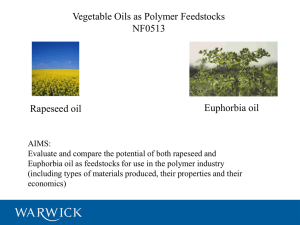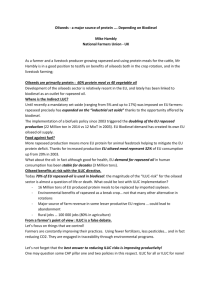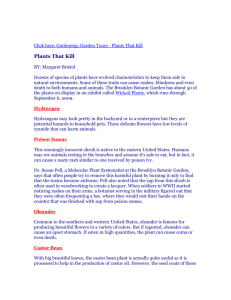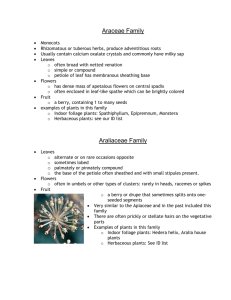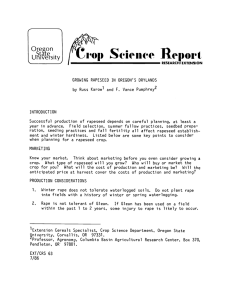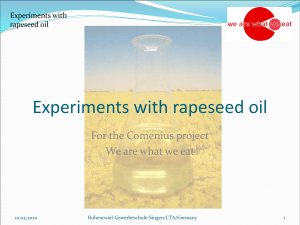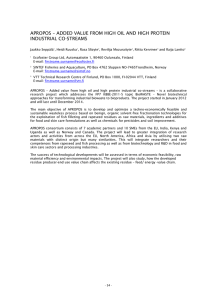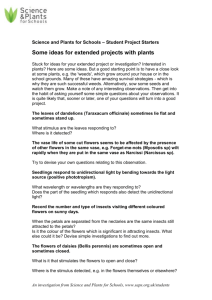Research areas
advertisement
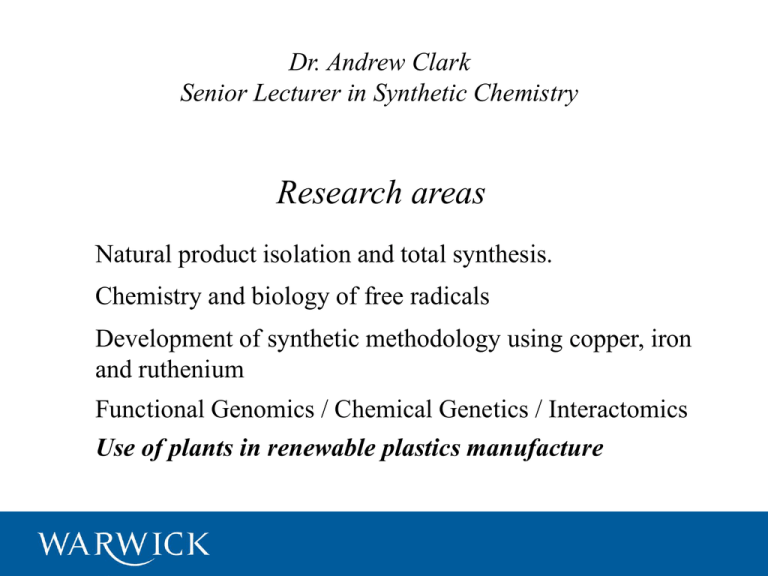
Dr. Andrew Clark Senior Lecturer in Synthetic Chemistry Research areas Natural product isolation and total synthesis. Chemistry and biology of free radicals Development of synthetic methodology using copper, iron and ruthenium Functional Genomics / Chemical Genetics / Interactomics Use of plants in renewable plastics manufacture Use of plants in renewable plastics manufacture POLYMERS and COMPOSITES Resins/Monomers Normally made from organic chemicals which are petrochemical in origin. Plant oils e.g. rape oil, linseed oil, sunflower oil, soya oil Strengtheners Normally a fibre incorporated into the polymer to increase mechanical strength. Plant fibres e.g. hemp, flax, jute, miscanthus Fillers Cheap organic or inorganic materials used to bulk the polymers and to alter physical properties Plant protein / waste e.g. rape meal ADVANTAGES OF PLANT PRODUCTS OVER PETROCHEMICALS Non-toxic, Biodegradable, Non-polluting in water courses, Sustainable, Recyclable? Besides a competitive price, the chemical industry also wants improved or new properties from end products derived from vegetable oils Vegetable Oils as Polymer Feedstocks (monomers) Euphorbia oil Rapeseed oil Plant fibres for composites Jute Hemp : Specific tensile strengths of synthetic and natural fibres COMMON MONOMER FEEDSTOCKS POLYURETHANES OH hydroxylated monomers OH Flexible and rigid foams elastomers and extrusions, coatings, adhesives POLYESTERS Flooring, autobody repair, boat hulls O Epoxidised monomers O EPOXY RESINS Protective coatings, adhesives flooring, plasticizers, foams 10 6 tonnes per annum POLYURETHANES O OH hydroxylated monomers OH hydroxylated monomers NCO Isocyanate monomers NCO catalyst O O HN Isocyanate monomers Renewable sources of monomers for polyurethane synthesis OH hydroxylated monomers OH TYPE 1 CASTOR OIL TYPE 2 CARDANOL cashew nut shell liquid OH O O R O COR O R O OH C15H29 steps N N C15H29 OH OH oleic O O R O O R O R O linoleic linolenic O Vernolic Rapeseed O O R O O R O R O Euphorbia acid, H 2O H2O2, W, H 3PO4 Room temperature OH OH O epoxide acid, H 2O OH OH alcohol HO O ring opening epoxidation RAPESEED RAPESEED RAPESEED OH HO O OH RASOR OH OH OH OH O epoxidation EUPHORBIA RAPESEED OH OH OH OH high-EURE HO OH ring opening EUPHORBIA ring opening O EUPHORBIA RAPESEED HO OH low-EURE INFRA RED OF RAPESEED AND HYDROXYLATED RAPESEED O epoxidation RAPESEED RAPESEED O HO OH ring opening RAPESEED HO OH RASOR HO OH OH HO RAPESEED + HO O O HO OH OH HO HO OH OH O O RAPESEED HO OH RAPESEED HO RAPESEED O OH HO OH OH O OH OH OH OH OH O epoxidation EUPHORBIA RAPESEED OH OH OH OH high-EURE HO OH ring opening EUPHORBIA ring opening O EUPHORBIA RAPESEED HO OH low-EURE 100 Transmittance (%) 80 60 OH 40 C=O Euphorbia low-OH Euphorbia high-OH 20 0 4000 3500 3000 2500 2000 1500 1000 -1 Wavenumber (cm ) Infra Red of modified low hydroxylated and high hydroxylated euphorbia POLYMERISATION THREE CLASSES of RESIN RAPESEED HYDROXYLATED RESIN (RASOR) EUPHORBIA HIGH HYDROXYLATED RESIN (high-EURE) EUPHORBIA LOW HYDROXYLATED RESIN (low-EURE) DI-ISOCYANATES MDI TDI COMPOSITES HEMP (H) MISCANTHUS FLAX JUTE (J) COMPRESSION MOULDING 100 Transmittance (%) 80 60 OH and NH NCO 40 C=O Euphorbia-OH Euphorbia 50min Rapeseed 50min 20 0 4000 3500 3000 2500 2000 1500 1000 -1 Wavenumber (cm ) IR spectra of 50 min cured rapeseed and euphorbia oil Differential scanning calorimetry (DSC) analysis: 200 180 RASOR Heat of reaction (delta H-J/g) 160 140 120 100 80 60 40 20 0 0 10 20 30 40 50 60 70 80 90 Time (min) Isothermal cure characteristics of MDI polymerised o rapeseed resin (50 C, 180 J/g) THERMAL GRAVIMETRIC ANALYSIS OF MATERIALS The loss in mass as a function of temperature Rapeseed oil Hydroxylated oil MDI polymerised Hemp-RASOR composite 100 Mass loss (%) 80 60 40 RAPESEED 20 0 0 200 400 600 o Temperature ( C) 800 THERMAL GRAVIMETRIC ANALYSIS OF MATERIALS The loss in mass as a function of temperature RAPESEED EUPHORBIA 100 Rapeseed oil Hydroxylated oil MDI polymerised Hemp-RASOR composite 100 80 Mass loss (%) Mass loss (%) 80 60 40 Euphorbia oil Hydroxylated Euphorbia resin Hemp-EURE composite 60 40 20 20 0 0 0 200 600 400 o Temperature ( C) 800 0 200 400 600 o Temperature ( C) 800 THERMAL GRAVIMETRIC ANALYSIS OF MATERIALS EUPHORBIA 30 Neat EURE Hemp-EURE Mass loss (%) 25 20 15 10 5 0 0 200 400 600 800 o Degradation temperature ( C) 1000 Untreated and alkali treated hemp-EURE and hemp-RASOR composites 45 40 HEURE low-OH HEURE high-OH Alk HEURE high-OH 40 Untreated HRASOR Alk HRASOR 30 Tensile strength (MPa) Tensile strength (MPa) 35 30 25 20 15 20 10 10 5 0 0 0 1 2 3 Strain (%) 4 5 0.0 0.5 1.0 1.5 2.0 Strain (%) 2.5 3.0 3.5 Composite type Fibre volume (%) Tensile strength (MPa) Young’s Modulus (GPa) Composite density (Kg/m3) Impact strength (kJ/m2) ILSS (MPa) HEURE-lowOH 21.05 22.91 (1.06) 2.31 649.55 18.81 (2.17) 3.12 HEURE-highOH 18.89 26.56 (1.85) 2.78 625.07 7.03 (1.13) 3.49 (0.45) HRASOR 19.92 38.84 (2.21) 3.40 697.09 9.25 (1.21) 3.88 (0.45) AHEURE-highOH 20.39 34.69 (3.76) 3.13 675.46 9.15 (1.64) 4.73 (0.76) AHRASOR 19.20 23.82 (2.96) 2.35 633.16 10.47 (2.01) 3.81 (0.43) JEURE-highOH 23.77 55.52 (2.60) 4.26 658.59 10.60 (2.27) 4.95 (0.43) JRASOR 23.74 46.38 (3.37) 3.89 704.93 13.70 (1.95) 3.99 (0.82) AJEURE-highOH 22.69 26.76 (2.23) 2.52 663.34 8.33 (0.88) 3.45 (0.45) AJRASOR 22.70 26.84 (1.60) 2.61 655.23 13.34 (1.78) 3.55 (0.66) 60 Tensile strength (MPa) 50 40 30 20 10 0 1 JEURE high-OH 2 AJEURE high-OH 3 JRASOR 4 AJRASOR 22 20 16 2 Impact strength (kJ/m ) 18 14 12 10 8 6 4 2 0 Unhemp -EURE low-OH Unhemp -EURE high-OH Alkhemp -EURE high-OH Unhemp RASOR ALkhemp -RASOR SCANNING ELECTRON MICROSCOPY RAPESEED PU EUPHORBIA PU RAPESEED-HEMP COMPOSITE EUPHORBIA-HEMP COMPSITE WEATHERABILITY NO evidence of major decomposition after 6 months simulated Solar UV radiation BIODEGRADABILITY Samples buried in bags 6 x 6 cm (pore size 20 micron) Bags recovered after three and six weeks Weight loss and colonising flora analysis Sample Weight loss after 6 weeks [%] Euphorbia polyurethane (EURE) 15.2 Rapeseed polyurethane/hemp composite (hemp-RASOR) 52.2 Euphorbia polyurethane/hemp composite (hemp-EURE) 50.3 Rapeseed polyurethane (EURE) 12.4 BIODEGRADABILITY RASOR SEM 123 4 5 6 7 8 910111213 1= 3 weeks hemp-EURE 2= 3 weeks hemp-RASOR 3= 6 weeks hemp-EURE 4= 6 weeks hemp-RASOR 1 = ladder DNA, 2-5 = soil DNA, 6-9 = 3 wks, 10-13 = 6 wks 6, 10 = microflora DNA from EURE 7, 11 = microflora DNA from hemp-RASOR 8, 12 = microflora DNA fromhemp-EURE 9, 13 = microflora DNA from RASOR 1 2 3 4 Economics. Cost of oil production per kilo Euphorbia lagascae £1.61 Rapeseed oil £2.11 Castor oil £1.21 * not including import costs Cost of complete polyurethane production per kilo Euphorbia lagascae £1.54 Rapeseed oil £1.88 Petrochemical £2.50-£9.50 Energy required in monomer production 1.9kg of fossil fuel per kg of monomer Equates to 3.1 kg of CO2 emissions per Kg of monomer CONCLUSIONS AND RELEVANCE A range of materials from rapeseed oil and euphorbia oil have been prepared and analysed. Properties of materials produced differ depending upon the type of oil used. Fibre composites of resins give superior properties to resins alone. Biodegradability may be controllable The increased range of materials available from this project will broaden the portfolio of potential industrial applications of materials from renewables which should lead to an increased value added market for fibres and oil crops in the UK agricultural sector. Euphorbia lagascae is a potential new crop for renewable materials production Future work In depth biodegradation studies. Can we control rate of degradation? Use of other oilseed crops and fibre crops. Use of fillers (rapemeal) Portfolio of materials from renewables to showcase to industry ACKNOWLEDGEMENTS Chemistry Department, University of Warwick, Coventry, CV4 7AL Dr. A. J. Clark, Project leader, Chemistry, monomer production Dr. L. Mwaikambo, Polymer synthesis and characterisation Prof. T. J. Kemp, Weatherometry Mrs. A. Mohd Rus, Weatherometry Advanced Technology Centre, Warwick Manufacturing Group, University of Warwick, Coventry, CV4 7AL, Dr. N. J. Tucker, Project leader, Composites, mechanical testing Biological Sciences, University of Warwick, Coventry, CV4 7AL, Dr. M. Krsek, Biodegradability Prof. E. M. H. Wellington, Biodegradability ADAS (Euphorbia supplier) Mr. D. Turley, Malton, N Dr. R. M. Weightman Boxworth, Formally of ADAS, High Mowthorpe, Duggleby, Yorks, YO17 8BP. ADAS Consultancy Ltd, Battlegate Road, Cambs, CB3 8NN
